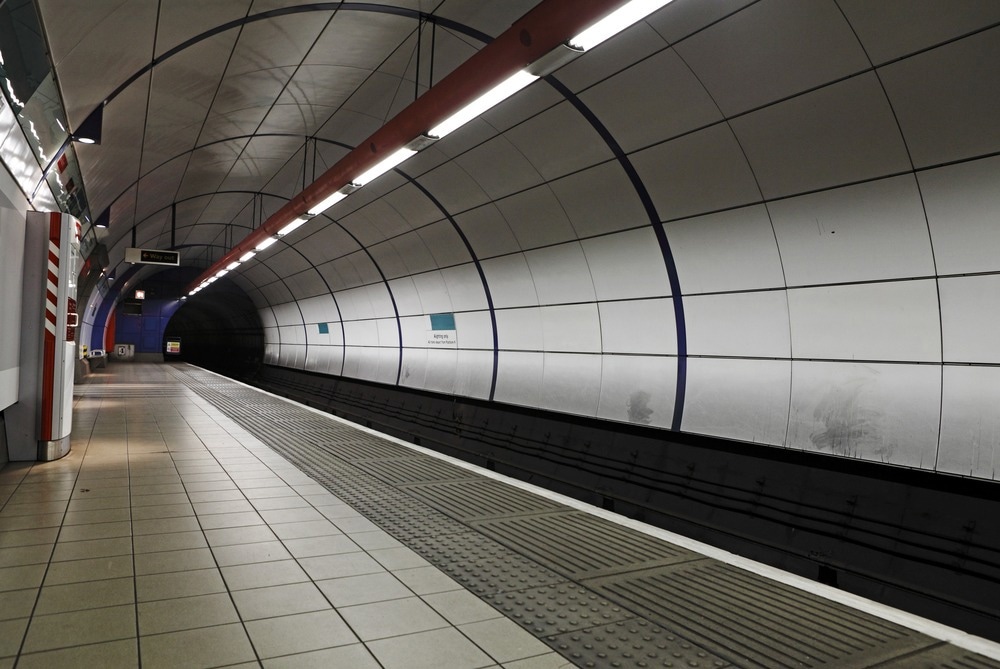Airborne iron oxide nanoparticles in the London Underground (LU) are the subject of a recent study published in the journal Scientific Reports. The purpose of this study is to characterize the composition, size, and mineralogy of iron-containing particles in the air of the LU, which can be hazardous to the health of commuters frequenting it. The study was carried out by a research group from the University of Cambridge.

Image Credit: dade72/Shutterstock.com
Five million people use the LU every day. Numerous studies have demonstrated that air pollution on the LU is higher than the levels found in London as a whole and exceeds World Health Organization-established standards. According to earlier research, the wheels, rails, and brakes on the LU produce the majority of the microscopic, iron-rich particles that make up particulate pollution.
Exposure to ultrafine particles from ambient air pollution has been linked to many adverse health effects. For example, impaired cognitive function, lung cancer, dementia, brain damage, and asthmatic health problems. Particularly, magnetite particulate matter's impact on human health has been associated with Alzheimer's disease. Moreover, magnetite nanoparticles have been discovered in the brain, which could have detrimental effects.
Standard air filters are typically used to measure pollution levels, however, they are unable to catch ultrafine particles and cannot tell what types of particles are contained in the particulate matter.
The health risks caused by iron-bearing particles from industrial and vehicle sources as opposed to those posed by subsurface sources are poorly understood and are believed to depend on a number of variables.
New Study Investigates Particulate Matter in the London Underground
The goal of the study conducted by the Cambridge team is to characterize the features of the particulate matter in the LU in the most thorough manner to date.
Thirty-nine dust samples provided by the Transport for London (TfL) were examined in this study. The samples were taken in 2019 and 2021 from train operator cabins, ticket halls, and platforms.
A variety of experimental techniques were employed to describe the composition, size, structure, shape, and magnetic properties of the particles present in the samples.
The researchers used a combination of low-temperature (LT), high-temperature (HT), and room-temperature (RT) magnetic techniques, first-order reversal curves (FORCs), scanning electron microscopy (SEM), energy-dispersive X-ray spectroscopy (EDS), transmission electron microscopy (TEM), and three-dimensional electron tomography.
Experimental Details
Particulate matter was magnetically characterized at various temperatures. A combination of an LT magnetization protocol and HT magnetic susceptibility measurements were carried out to assess the mineralogical makeup of the iron-oxide phase in LU particulate matter.
LT saturation isothermal magnetization remanence measurements were used to find the overall magnetic content of the dust samples. Further, the role of ferromagnetic granules with stable remanence was identified by RT magnetic investigation.

Image Credit: Gwoeii/Shutterstock.com
The variety of magnetic domain states, and as a result, the range of particle sizes present, as well as any magnetostatic interactions between particles, were assessed using first-order reversal curves.
Scanning electron microscopy (SEM), transmission electron microscopy (TEM), and three-dimensional electron tomography are powerful tools for analyzing particulate matter at high resolution.
The air filter sample's initial SEM investigations reveal agglomerated Fe-bearing particles in micron- to sub-micron-sized clusters. The existence of rounder iron-oxide nanoparticles was confirmed by scanning transmission electron microscopy (STEM). Particles from a high-magnification region exhibit electron diffraction patterns that are compatible with a magnetite-maghemite spinel phase.
An in-depth study of the 3D structure and size distribution of nanoparticles was facilitated by electron tomography. Images of isolated and aggregated particles reveal that the majority of the particles have a spherical shape, with only a small number having an elongated shape, which is consistent with the rounded morphologies seen by SEM and STEM.
Discussion and Future Outlook
The results from the Cambridge team provided a thorough analysis of the pollutants distributed in the air in the LU. They discovered a significant number of maghemite particles, with an average diameter of 10 nanometers and a diameter range from 5 to 500 nanometers. Some particles organized into larger clusters that ranged in size from 100 to 2,000 nanometers were also observed.
The London Underground has a very high level of particulate matter pollution with a high concentration of iron. Iron oxides could pose a serious threat to your health because they are likely to lead to oxidative stress.
According to the researchers, the air quality on platforms can be worse than in ticket halls or operator cabins because of the Underground's inadequate ventilation, which can cause iron-rich dust to be suspended in the air when trains arrive at platforms.
The researchers propose that an effective removal technique might include cleaning the tracks and interior tunnel walls, installing screen doors between platforms and trains due to the magnetic nature of the suspended dust, or using magnetic filters in ventilation
To estimate the real exposure to nano-iron oxide particles, more research on the ambient size distribution of iron oxide particles would be ideal. Samples of particulate matter may have undergone post-processing that altered their size and composition. Observations of the number, size distribution, and direct sampling of the nanoparticles for TEM studies may be combined in future work, with the use of the Scanning Mobility Particle Sizer.
More from AZoOptics: Electron Microscopy Unveils Secrets of Roman Concrete
References and Further Reading
Sheikh, H.A., Tung, P.Y., Ringe, E. et al. Magnetic and microscopic investigation of airborne iron oxide nanoparticles in the London Underground. Sci Rep 12, 20298 (2022). https://doi.org/10.1038/s41598-022-24679-4
Collins, S. (15 December 2022) London Underground polluted with metallic particles small enough to enter human bloodstream. [Online] University of Cambridge. Available at: https://www.cam.ac.uk/stories/london-underground-pollution
Sivarajah, I. (10 February 2022) How Cryogenic Electron Microscopy is Advancing Battery Design. [Online] AZoOptics.com. Available at: https://www.azooptics.com/Article.aspx?ArticleID=2144
https://www.sciencemediacentre.org/expert-reaction-to-study-of-iron-oxide-nanoparticles-in-the-london-underground/
https://www.cam.ac.uk/stories/london-underground-pollution
Disclaimer: The views expressed here are those of the author expressed in their private capacity and do not necessarily represent the views of AZoM.com Limited T/A AZoNetwork the owner and operator of this website. This disclaimer forms part of the Terms and conditions of use of this website.